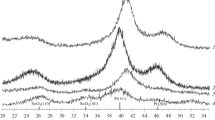Abstract
Nanostructured platinum-based electrocatalysts modified with tin dioxide (SnO2) are studied for their performance in highly efficient oxidation of an alcohol additive (methanol) to the hydrogen flow in fuel cells with proton exchange membrane designed for operation in low temperature conditions (to –50°C). The activity of electrocatalysts in the oxygen reduction reaction (ORR) and the methanol oxidation reaction is studied by the rotating disk electrode technique. The catalysts Pt20/10 wt %–SnO2/C and Pt20/C exhibit higher ORR activity (specific activity around 0.25 mA/cm2) than Pt40/C in a 0.1 M HClO4 solution. The activity of catalyst Pt20/10 wt %–SnO2/C nearly doubles in a solution containing methanol at 4 wt %, suggesting its high activity in methanol oxidation reaction. For the platinum in Pt20/10 wt %–SnO2/C, the electrochemical active surface area is 58 m2/g, which exceeds this parameter for Pt40/C (43 m2/g). Nanoscale Pt–SnO2 heteroclusters in the electrocatalyst Pt20/10 wt %–SnO2/C ensure its high activity in the electrooxidation reactions of both methanol and hydrogen, and they are also effective as a catalyst for the anode. Their high ORR activity, along with improved durability, compared to Pt40/C and Pt20/C catalysts, ensures their efficiency as cathode catalysts in fuel cell.




Similar content being viewed by others
REFERENCES
Autonomous Non–Commercial Organization 'International Sustainable Energy Development Centre’ under the auspices of UNESCO. http://www.isedc–u.com/1248–dostup–k–energii.html.
S. Golubchikov, Energy 11, 35 (2002).
M. K. Debe, Nature (London, U.K.) 486, 43 (2012). https://doi.org/10.1038/nature11115
M. Amjadi, S. Rowshanzamir, S. J. Peighambardoust, and S. Sedghi, J. Power Sources 210, 350 (2012). https://doi.org/10.1016/j.jpowsour.2012.03.011
Z. F. Pan, L. An, and C. Y. Wen, Appl. Energy 240, 473 (2019). https://doi.org/10.1016/j.apenergy.2019.02.079
D. Banham and S. Ye, ACS Energy Lett. 2, 629 (2017). https://doi.org/10.1021/acsenergylett.6b00644
M. T. Anwar, X. Yan, M. R. Asghar, et al., Int. J. Energy Resour. 43, 1 (2018).
D. Chakraborty, H. Bischoff, I. Chorkendorff, and T. Johannessen, J. Electrochem. Soc. 152, 2357 (2005). https://doi.org/10.1149/1.2109547
E. H. Jung, U. H. Jung, T. H. Yang, et al., Int. J. Hydrogen Energy 32, 903 (2007). https://doi.org/10.1016/j.ijhydene.2006.12.014
F. Knorr, D. G. Sanchez, J. Schirmer, et al., Appl. Energy 238, 1 (2019). https://doi.org/10.1016/j.apenergy.2019.01.036
D. D. Spasov, N. A. Ivanova, A. S. Pushkarev, et al., Catalysts 9, 803 (2019). https://doi.org/10.3390/catal9100803
Y. Nakazato, D. Kawachino, Z. Noda, et al., J. Electrochem. Soc. 165, 1154 (2018). https://doi.org/10.1149/2.0311814jes
L. Du, Y. Shao, J. Sun, et al., Nano Energy 29, 314 (2016). https://doi.org/10.1016/j.nanoen.2016.03.016
L. A. Frolova, Y. A. Dobrovolsky, and N. G. Bukun, Rus. J. Electrochem. 47, 697 (2011). doi.org/https://doi.org/10.1134/S1023193511060024
K. Zhang, C. Feng, B. He, et al., J. Electroanal. Chem. 781, 198 (2016). doi.org/https://doi.org/10.1016/j.jelechem.2016.11.002
L. Jiang, G. Sun, Z. Zhou, et al., J. Phys. Chem. 109, 8774 (2005). https://doi.org/10.1021/jp050334g
F. Labbé, T. Asset, M. Chatenet, et al., Electrocatalysis 10, 156 (2019). https://doi.org/10.1007/s12678-018-0505-z
A. Kowal, S. L. Gojković, K.–S. Lee, et al., Electrochem. Commun. 11, 724 (2009). https://doi.org/10.1016/j.elecom.2009.01.022
N. Zhang, S. Zhang, C. Du, et al., Electrochim. Acta 117, 413 (2014). https://doi.org/10.1016/j.electacta.2013.11.139
S. Hussain, N. Kongi, H. Erikson, et al., Electrochim. Acta 316, 162 (2019). https://doi.org/10.1016/j.electacta.2019.05.104
I. Jiménez-Morales, S. Cavaliere, D. Jones, and J. Rozière, Phys. Chem. Chem. Phys. 20, 8765 (2018). https://doi.org/10.1039/C8CP00176F
M. Yin, J. Xu, Q. Li, et al., Appl. Catal., A 144, 112 (2014). https://doi.org/10.1016/j.apcatb.2013.07.007
G. Yang, L. M. Namin, N. Aaron Deskins, and X. Teng, J. Catal. 353, 335 (2017). https://doi.org/10.1016/j.jcat.2017.07.033
S. A. Grigoriev, P. Millet, and V. N. Fateev, J. Power Sources 177, 281 (2008). https://doi.org/10.1016/j.jpowsour.2007.11.072
N. A. Ivanova, O. K. Alekseeva, V. N. Fateev, et al., Int. J. Hydrogen Energy 44, 29529 (2019). https://doi.org/10.1016/j.ijhydene.2019.04.096
Ya. Koutetskii and V. G. Levich, Dokl. Akad. Nauk 117, 441 (1957).
Y. Garsany, O. A. Baturina, and K. E. Swider-Lyons, ACS Publ., 6321 (2010). doi.org/https://doi.org/10.1021/ac100306c
H. A. Gasteiger, S. S. Kocha, B. Sompalli, and F. T. Wagner, Appl. Catal., B 56, 9 (2005). https://doi.org/10.1016/j.apcatb.2004.06.021
Y. Garsany, I. L. Singer, and K. E. Swider-Lyons, J. Electroanal. Chem. 662, 396 (2011). https://doi.org/10.1016/j.jelechem.2011.09.016
N. Zhang, S. Zhang, C. Du, et al., Electrochim. Acta 117, 413 (2014). https://doi.org/10.1016/j.electacta.2013.11.139
A. S. Pushkarev, I. V. Pushkareva, N. A. Ivanova, et al., Catalysts 9, 271 (2019). doi.org/https://doi.org/10.3390/catal9030271
W. He, J. Liu, Y. Qiao, et al., J. Power Sources 195, 1046 (2010). https://doi.org/10.1016/j.jpowsour.2009.09.006
R. C. Koffi, C. Coutanceau, E. Garnier, et al., Electrochim. Acta 50, 4117 (2005). https://doi.org/10.1016/j.electacta.2005.01.028
Funding
This work was supported by the Russian Foundation for Basic Research (project nos. 20-08-00927, 18-29-23030).
Author information
Authors and Affiliations
Corresponding author
Additional information
Translated by A. Kukharuk
Rights and permissions
About this article
Cite this article
Spasov, D.D., Mensharapov, R.M., Zasypkina, A.A. et al. Nanoscale Pt–SnO2 Heteroclusters in Electrocatalysts for Oxygen Reduction and Methanol Oxidation Reactions. Nanotechnol Russia 15, 723–729 (2020). https://doi.org/10.1134/S1995078020060191
Received:
Revised:
Accepted:
Published:
Issue Date:
DOI: https://doi.org/10.1134/S1995078020060191




